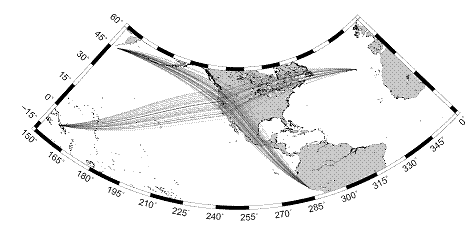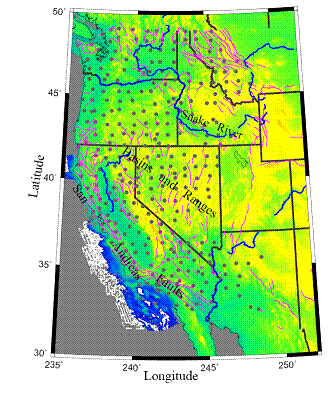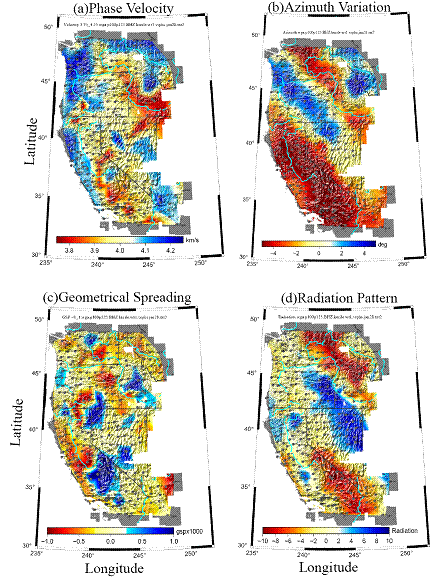Wave Gradiometry / Wave Gradient Analysis
(1)
Theory. (2) Application to the
USArray.
~~~~~~~~~~~~~~~~~~~~~~~~~~~~~~~~~~~~~~~~~~~~~~~~~~~~~
(2) Wave gradiometry
applied to the USArray.
USArray provides an
excellent test-bed for the Wave Gradiometry (WG)
technique. In this section, we present results from waveforms recorded by
USArray from 4 earthquakes from different azimuths. The ray paths of 4 earthquakes
are shown in the Figure 1b. This method can ideally be applied to any
identifiable phases. The applications for Rayleigh waves and body waves are
present in section (2.1) and (2.2), respectively.
(2.1 ) Surface waves.
Figure 1a is a snapshot of
the USArray. Figure 1b shows ray paths used in this study. Only results from
one earthquake are discussed on this page though. The 4 WG parameter maps
determined by WG are shown in the Figure 2. Figure 3 shows how the azimuth
variations determined by WG can be associated with tectonic structure along
wave paths.
![]()



Figure 1a: USArray and
Figure 1b: Ray paths of 4 earthquakes used
in this study. But
only results from the

Figure 2. Four WG parameter maps. Four maps derived from an
earthquake from the ![]() and radiation pattern
and radiation pattern ![]() should be understood
as amplitude variations in the radial and azimuthal
directions, respectively. See the “Interpretations” for details.
should be understood
as amplitude variations in the radial and azimuthal
directions, respectively. See the “Interpretations” for details.


Figure 3: Ray paths and azimuth variations
of the
Interpretations:
(a)
Phase
velocity: Phase velocity perturbations (Figure 2a) with respect to an
average velocity of 4.05km/s. The western coast of the
(b)
Azimuth
variations: Strong path direction dependency is obvious for azimuth variations
in Figure (2b). Figure 3 shows both ray paths and the azimuth variations. A
velocity contrast of 0.25km/s between the oceanic lithosphere to west and the
continental lithosphere to east is enough to account for the negative anomaly
at
(c)
Geometrical
Spreading: The geometrical spreading
map (Figure 2c) shows little distance dependency. Instead, strong
anti-correlation between the phase velocity map and the geometrical spreading
map is observed. For example, the high velocity western coast of
(d)
Radiation
Pattern: Similar to the
azimuth variation, the radiation pattern (Figure 2d) is also strongly dependent
on ray paths. This suggests that the dramatical azimuthal amplitude variation may be due to the scattering
along the path. Similar to the azimuth variations, the Aleutian subduction zone may also play a big role to change the
amplitude azimuthally.
(2.2 ) Body waves:
in preparation.
References:
(1) Langston, C. A.(2007), Spatial Gradient Analysis for Linear Seismic Arrays, BSSA, Vol. 97, No. 1B, 265-280.
(2) Langston, C. A.(2007), Wave Gradiometry in Two Dimensions, BSSA, Vol. 97, No. 2, 401-416.
(3) Langston, C. A.(2007), Wave Gradiometry in the Time Domain, BSSA, Vol. 97, No. 3, 926-933.
(4) Langston, C. A. C. Liang (2008), Wave Gradiometry for polarized waves, in review.
(5) Liang,
C., C. A. Langston (2008), Wave Gradiometry for
USArray, in review.